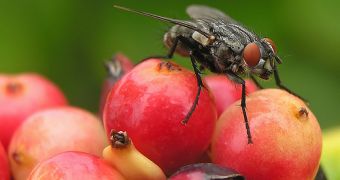Everyone knows that obesity strikes the heart sooner or later, but a new study on fruit flies detailed the link between obesity and heart disease.
With over a third of Americans being obese, many of them have a high risk of developing cancer, diabetes and heart disease, but because for these conditions there are other causes as well, this new study carried out by Sanford-Burnham Medical Research Institute (Sanford-Burnham) was necessary.
A team of researchers led by Sean Oldham, PhD, and Rolf Bodmer, PhD, created a simple model that shows the connection between high-fat diet, obesity and heart dysfunction.
The team used fruit flies, and found that a protein called TOR, determines the fat accumulation in the heart, so manipulating it, actually protects the heart of fruit flies from high-fat damage-causing diets.
For the experiment, fruit flies were fed a high-fat diet of coconut oil; once they became obese, they presented the same symptoms as obese people, heart problems included.
In order to see the way that TOR works, Dr. Oldham and his team generated flies that had a lower activity of this protein.
TOR is normally restraining the enzyme that breaks down fat so by inhibiting it, the team boosted the fat-digesting enzyme, thus reducing fat accumulation in the heat, and improved the health of obese flies' hearts.
The researchers got the same results when they blocked TOR in the whole fly, just in heart cells or just in fat tissue.
They chose the fruit fly for this study because, despite everything, most of its basic molecular mechanisms are very much like those of vertebrates.
Also, it is very easy to delete individual genes in the fly and find out the role that each one plays in heart development and function.
Dr. Oldham, which is also a co-senior author of the study, said that they “noticed previously that reducing TOR had a large number of beneficial effects on aging.
“We next wanted to look at TOR activity in obesity-related heart disease, but we didn't have a good system.
“In this study, we establish the fruit fly as a model for obesity caused by a high-fat diet.”
“These results open the possibility that we can intervene with the effects of obesity by targeting TOR and other proteins it regulates – either directly in fat or in a specific organ like the heart,” explains Dr. Bodmer, co-senior author of the study and professor and director of the Development and Aging Program.
“One thing we'd like to know next is if fats themselves are toxic to the heart, or is it the byproducts of their metabolism that are harmful,” added Dr. Birse, post-doctoral researcher and lead author of the study.
“One good thing about using fruit flies is that, in theory, we could feed them whatever we want to screen – different fatty acids, molecules, drugs, etc. – to observe their effects on the heart or other systems.”
This should allow researchers to find answers to most questions about diet, heart and obesity.
The findings are published in the journal Cell Metabolism.
Fly Study Uncovers Molecular Link Between Obesity and Heart Disease from Sanford-Burnham Institute on Vimeo.

 14 DAY TRIAL //
14 DAY TRIAL //